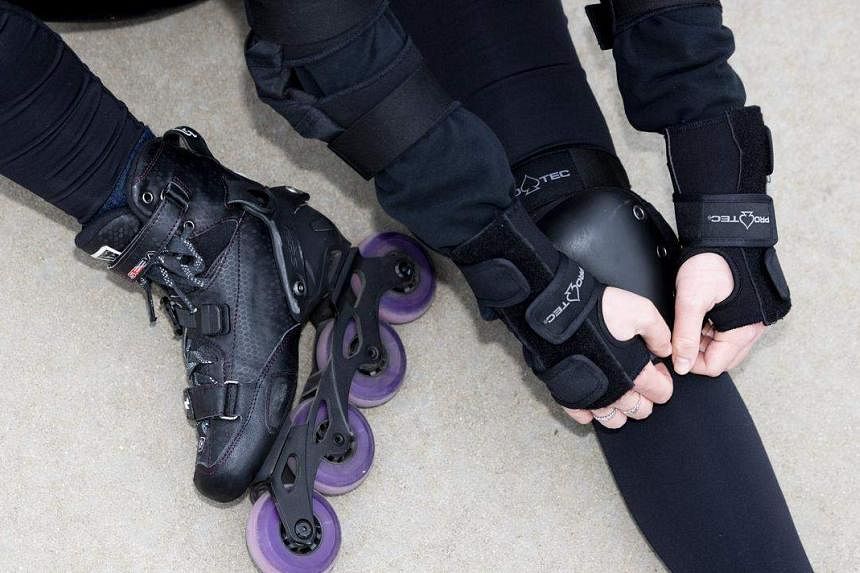NEW YORK – There was a time in the mid- to late 1990s when in-line skating was pretty much the coolest thing you could do. Back then, about 17 million people were “rollerblading”, as everyone called it, both for sport and recreation.
But then it fell from favour and, except for a brief return in the 2010s, lost its cool-kid appeal around the turn of the century.
Now it is making another comeback. There is a resurgence of skaters on paved pathways, city sidewalks and in local parks, according to the Sports & Fitness Industry Association. Some are new to the sport. For others, it is a nostalgic return to the past.
Like many outdoor sports, in-line skating became more popular during the pandemic. In May 2020, the company Rollerblade reported its highest shipping month in 20 years. While sales have levelled off since then, skates are still going the distance by offering serious physical benefits.
Shaking up your fitness routine with in-line skating has big physical payoffs, said Ms Esther Goldsmith, a London-based exercise and sports physiologist with bio-analytics firm Orreco.
“Depending on how you’re skating, you can reap both aerobic and anaerobic benefits,” she added. “You also engage a wide variety of muscles you might not from a sport like running or cycling.”
You will pull in stabilising muscles from your abs and calves, for instance, as well as inner and outer thigh muscles.
What sets in-line skating apart from sports such as hiking, running and most types of swimming is that you move in a lateral plane rather than just front and back. Over time, these types of functional muscles – those used in daily life – decline if not challenged in this manner.
“Skating takes your body side to side, involves your core and improves your balance,” said Ms Goldsmith.
Skating also trains your nervous system by requiring your body to do several movements at once, such as squatting and pushing off to the sides (especially if you are mixing up your style). This is helpful in both athletic and daily activities, said Ms Goldsmith.
“When your muscles and nerves are more prepared, it reduces the likelihood of tweaking your back, for example,” she added. “Skating trains your body for these daily activities without you realising it.”
Careering around on tiny wheels can have additional benefits later in life. For one, it provides an equal aerobic benefit to running but with less impact on the body, presuming you do not fall.
The payoff from learning to glide balanced on one foot at a time is also valuable.
“Our balance peaks in our late 30s and begins to decline in our 40s,” said Ms Goldsmith. “Many accidents happen over the age of 65 because of trips and falls. Skating regularly adds balance to the routine, and that can help slow down the decline.”
That does not mean skating is without risk. Falls happen, and sometimes sprains or broken bones accompany them. But by mastering foundational skills and wearing a helmet and wrist and knee guards, you can mitigate your chances of injury.

While it is tempting to break out a new pair of skates and simply go, your experience can be much better with a few lessons and basics, said Ms Brittany Strachan, coach and co-owner of Colorado Skate Fitness. Classes that teach foundational moves such as starting, stopping, turning and rolling might take eight weeks, she said.
“After that, you can progress to fitness-oriented classes,” she added.
Mr Arnav “Sonic” Shah, a certified skate instructor from New York, offers tips to get started. “Always start on flat terrain, like a basketball court, and learn how to stop before anything else,” he said.
Then follow these form tips: Bend your knees, keep your upper body upright, keep your head level and look ahead, place your hands in front of your body, bend and flex your ankles, place your feet about a fist-width apart and push out to the side, not back.
A sample fitness class, said Ms Strachan, is often designed to include high-intensity interval training and might involve a warm-up followed by some drill work, plus short bursts of skating combined with strength training.
In-line skating also comes in many flavours: endurance, speed, freestyle tricks and even dance. You might find mastering skate-park tricks or manoeuvres intriguing, or you may want to get a full-body workout from a skate fitness class. NYTIMES

